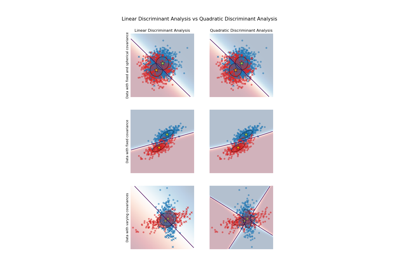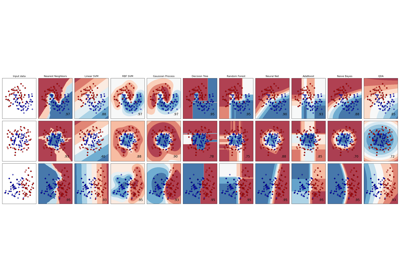QuadraticDiscriminantAnalysis#
- class sklearn.discriminant_analysis.QuadraticDiscriminantAnalysis(*, solver='svd', shrinkage=None, priors=None, reg_param=0.0, store_covariance=False, tol=0.0001, covariance_estimator=None)[source]#
Quadratic Discriminant Analysis.
A classifier with a quadratic decision boundary, generated by fitting class conditional densities to the data and using Bayes’ rule.
The model fits a Gaussian density to each class.
Added in version 0.17.
For a comparison between
QuadraticDiscriminantAnalysisandLinearDiscriminantAnalysis, see Linear and Quadratic Discriminant Analysis with covariance ellipsoid.Read more in the User Guide.
- Parameters:
- solver{‘svd’, ‘eigen’}, default=’svd’
- Solver to use, possible values:
‘svd’: Singular value decomposition (default). Does not compute the covariance matrix, therefore this solver is recommended for data with a large number of features.
‘eigen’: Eigenvalue decomposition. Can be combined with shrinkage or custom covariance estimator.
- shrinkage‘auto’ or float, default=None
- Shrinkage parameter, possible values:
None: no shrinkage (default).
‘auto’: automatic shrinkage using the Ledoit-Wolf lemma.
float between 0 and 1: fixed shrinkage parameter.
Enabling shrinkage is expected to improve the model when some classes have a relatively small number of training data points compared to the number of features by mitigating overfitting during the covariance estimation step.
This should be left to
Noneifcovariance_estimatoris used. Note that shrinkage works only with ‘eigen’ solver.- priorsarray-like of shape (n_classes,), default=None
Class priors. By default, the class proportions are inferred from the training data.
- reg_paramfloat, default=0.0
Regularizes the per-class covariance estimates by transforming S2 as
S2 = (1 - reg_param) * S2 + reg_param * np.eye(n_features), where S2 corresponds to thescaling_attribute of a given class.- store_covariancebool, default=False
If True, the class covariance matrices are explicitly computed and stored in the
self.covariance_attribute.Added in version 0.17.
- tolfloat, default=1.0e-4
Absolute threshold for the covariance matrix to be considered rank deficient after applying some regularization (see
reg_param) to eachSkwhereSkrepresents covariance matrix for k-th class. This parameter does not affect the predictions. It controls when a warning is raised if the covariance matrix is not full rank.Added in version 0.17.
- covariance_estimatorcovariance estimator, default=None
If not None,
covariance_estimatoris used to estimate the covariance matrices instead of relying on the empirical covariance estimator (with potential shrinkage). The object should have a fit method and acovariance_attribute like the estimators insklearn.covariance. If None the shrinkage parameter drives the estimate.This should be left to
Noneifshrinkageis used. Note thatcovariance_estimatorworks only with the ‘eigen’ solver.
- Attributes:
- covariance_list of len n_classes of ndarray of shape (n_features, n_features)
For each class, gives the covariance matrix estimated using the samples of that class. The estimations are unbiased. Only present if
store_covarianceis True.- means_array-like of shape (n_classes, n_features)
Class-wise means.
- priors_array-like of shape (n_classes,)
Class priors (sum to 1).
- rotations_list of len n_classes of ndarray of shape (n_features, n_k)
For each class k an array of shape (n_features, n_k), where
n_k = min(n_features, number of elements in class k)It is the rotation of the Gaussian distribution, i.e. its principal axis. It corresponds toV, the matrix of eigenvectors coming from the SVD ofXk = U S VtwhereXkis the centered matrix of samples from class k.- scalings_list of len n_classes of ndarray of shape (n_k,)
For each class, contains the scaling of the Gaussian distributions along its principal axes, i.e. the variance in the rotated coordinate system. It corresponds to
S^2 / (n_samples - 1), whereSis the diagonal matrix of singular values from the SVD ofXk, whereXkis the centered matrix of samples from class k.- classes_ndarray of shape (n_classes,)
Unique class labels.
- n_features_in_int
Number of features seen during fit.
Added in version 0.24.
- feature_names_in_ndarray of shape (
n_features_in_,) Names of features seen during fit. Defined only when
Xhas feature names that are all strings.Added in version 1.0.
See also
LinearDiscriminantAnalysisLinear Discriminant Analysis.
Examples
>>> from sklearn.discriminant_analysis import QuadraticDiscriminantAnalysis >>> import numpy as np >>> X = np.array([[-1, -1], [-2, -1], [-3, -2], [1, 1], [2, 1], [3, 2]]) >>> y = np.array([1, 1, 1, 2, 2, 2]) >>> clf = QuadraticDiscriminantAnalysis() >>> clf.fit(X, y) QuadraticDiscriminantAnalysis() >>> print(clf.predict([[-0.8, -1]])) [1]
- decision_function(X)[source]#
Apply decision function to an array of samples.
The decision function is equal (up to a constant factor) to the log-posterior of the model, i.e.
log p(y = k | x). In a binary classification setting this instead corresponds to the differencelog p(y = 1 | x) - log p(y = 0 | x). See Mathematical formulation of the LDA and QDA classifiers.- Parameters:
- Xarray-like of shape (n_samples, n_features)
Array of samples (test vectors).
- Returns:
- Cndarray of shape (n_samples,) or (n_samples, n_classes)
Decision function values related to each class, per sample. In the two-class case, the shape is
(n_samples,), giving the log likelihood ratio of the positive class.
- fit(X, y)[source]#
Fit the model according to the given training data and parameters.
Changed in version 0.19:
store_covarianceshas been moved to main constructor asstore_covariance.Changed in version 0.19:
tolhas been moved to main constructor.- Parameters:
- Xarray-like of shape (n_samples, n_features)
Training vector, where
n_samplesis the number of samples andn_featuresis the number of features.- yarray-like of shape (n_samples,)
Target values (integers).
- Returns:
- selfobject
Fitted estimator.
- get_metadata_routing()[source]#
Get metadata routing of this object.
Please check User Guide on how the routing mechanism works.
- Returns:
- routingMetadataRequest
A
MetadataRequestencapsulating routing information.
- get_params(deep=True)[source]#
Get parameters for this estimator.
- Parameters:
- deepbool, default=True
If True, will return the parameters for this estimator and contained subobjects that are estimators.
- Returns:
- paramsdict
Parameter names mapped to their values.
- predict(X)[source]#
Perform classification on an array of vectors
X.Returns the class label for each sample.
- Parameters:
- X{array-like, sparse matrix} of shape (n_samples, n_features)
Input vectors, where
n_samplesis the number of samples andn_featuresis the number of features.
- Returns:
- y_predndarray of shape (n_samples,)
Class label for each sample.
- predict_log_proba(X)[source]#
Estimate log class probabilities.
- Parameters:
- X{array-like, sparse matrix} of shape (n_samples, n_features)
Input data.
- Returns:
- y_log_probandarray of shape (n_samples, n_classes)
Estimated log probabilities.
- predict_proba(X)[source]#
Estimate class probabilities.
- Parameters:
- X{array-like, sparse matrix} of shape (n_samples, n_features)
Input data.
- Returns:
- y_probandarray of shape (n_samples, n_classes)
Probability estimate of the sample for each class in the model, where classes are ordered as they are in
self.classes_.
- score(X, y, sample_weight=None)[source]#
Return accuracy on provided data and labels.
In multi-label classification, this is the subset accuracy which is a harsh metric since you require for each sample that each label set be correctly predicted.
- Parameters:
- Xarray-like of shape (n_samples, n_features)
Test samples.
- yarray-like of shape (n_samples,) or (n_samples, n_outputs)
True labels for
X.- sample_weightarray-like of shape (n_samples,), default=None
Sample weights.
- Returns:
- scorefloat
Mean accuracy of
self.predict(X)w.r.t.y.
- set_params(**params)[source]#
Set the parameters of this estimator.
The method works on simple estimators as well as on nested objects (such as
Pipeline). The latter have parameters of the form<component>__<parameter>so that it’s possible to update each component of a nested object.- Parameters:
- **paramsdict
Estimator parameters.
- Returns:
- selfestimator instance
Estimator instance.
- set_score_request(*, sample_weight: bool | None | str = '$UNCHANGED$') QuadraticDiscriminantAnalysis[source]#
Configure whether metadata should be requested to be passed to the
scoremethod.Note that this method is only relevant when this estimator is used as a sub-estimator within a meta-estimator and metadata routing is enabled with
enable_metadata_routing=True(seesklearn.set_config). Please check the User Guide on how the routing mechanism works.The options for each parameter are:
True: metadata is requested, and passed toscoreif provided. The request is ignored if metadata is not provided.False: metadata is not requested and the meta-estimator will not pass it toscore.None: metadata is not requested, and the meta-estimator will raise an error if the user provides it.str: metadata should be passed to the meta-estimator with this given alias instead of the original name.
The default (
sklearn.utils.metadata_routing.UNCHANGED) retains the existing request. This allows you to change the request for some parameters and not others.Added in version 1.3.
- Parameters:
- sample_weightstr, True, False, or None, default=sklearn.utils.metadata_routing.UNCHANGED
Metadata routing for
sample_weightparameter inscore.
- Returns:
- selfobject
The updated object.
Gallery examples#

Linear and Quadratic Discriminant Analysis with covariance ellipsoid
